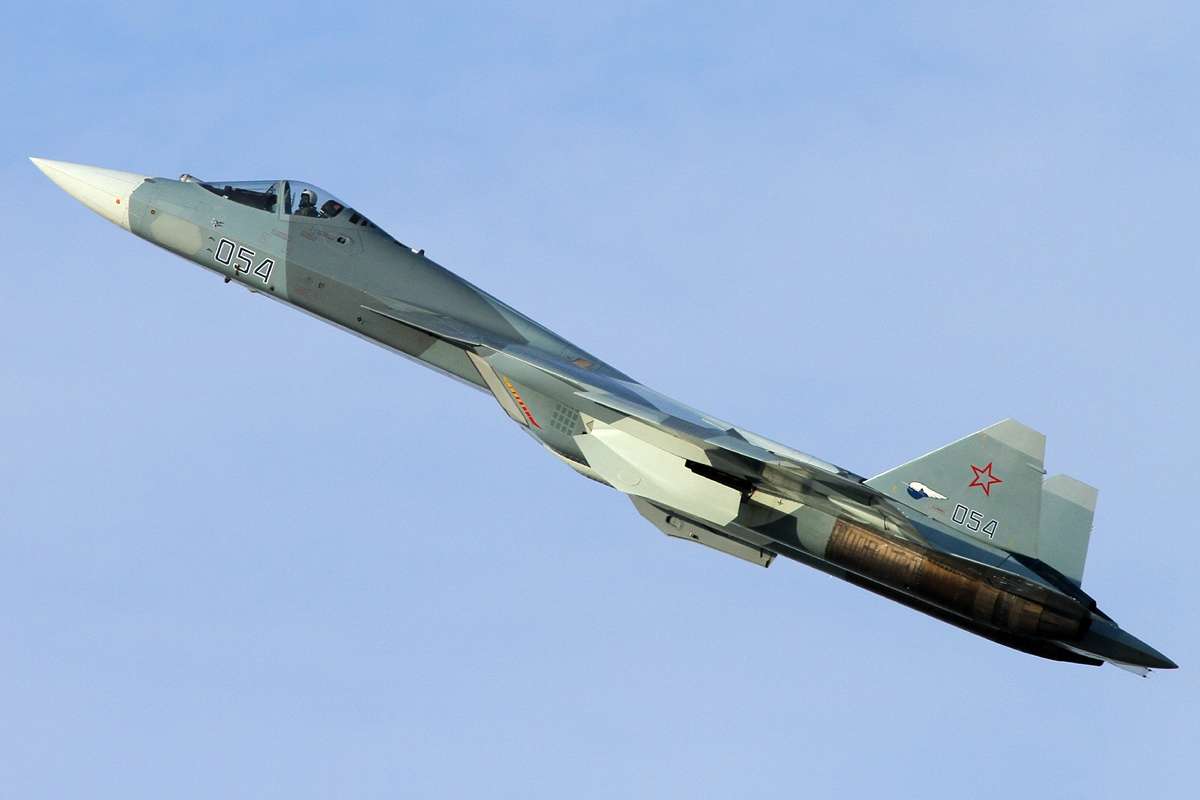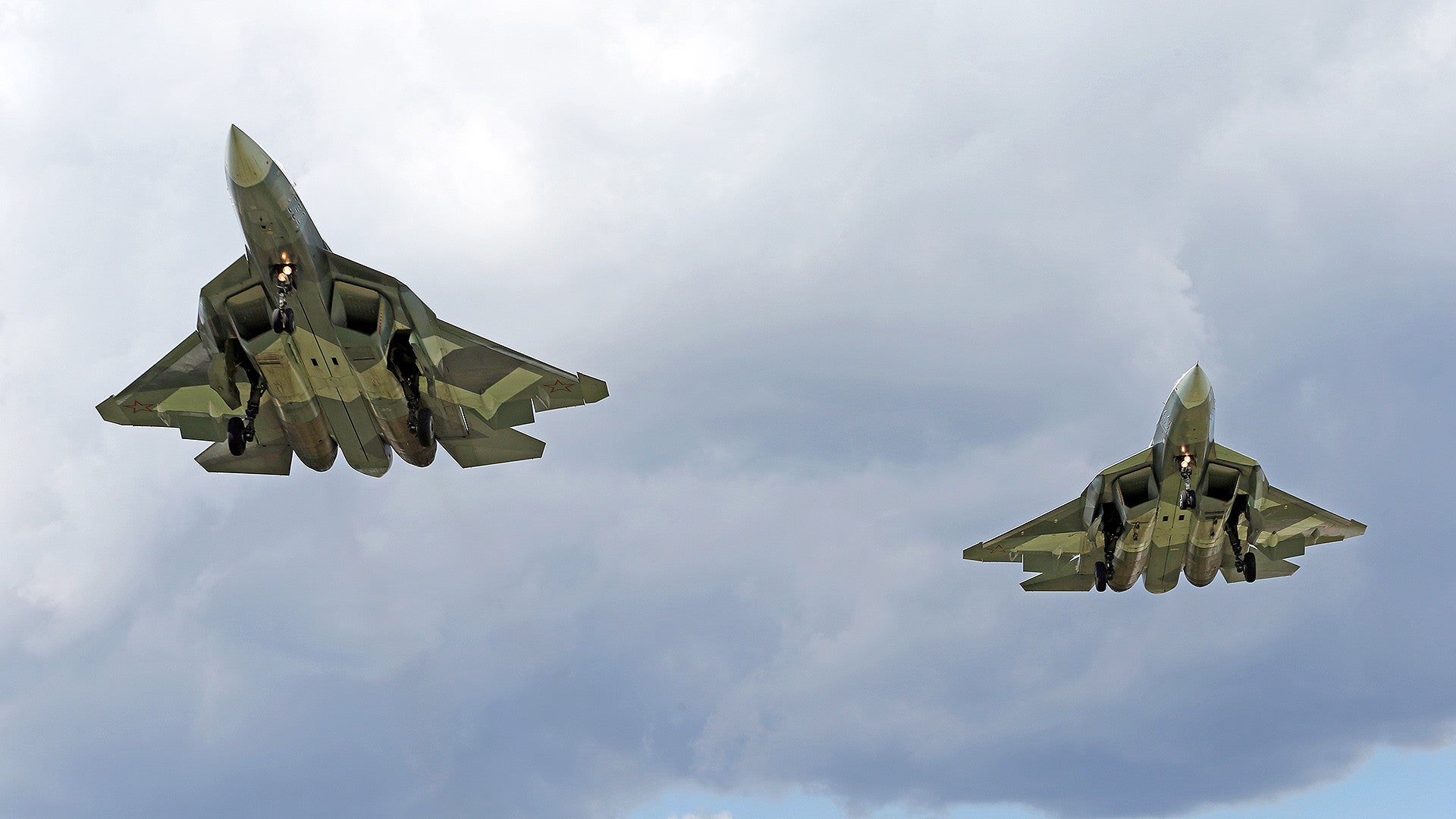Unverified pictures and video footage has begun to circulate on social media purporting to show a pair of Russian Su-57 fighters, also known as the PAK FA and T-50, touching down at the country’s Khmeimim air base in Syria’s Latakia province. The Kremlin has already used the Syrian conflict as an excuse to demonstrate new and advanced weaponry and even if this video turns out to not show operations in Syria, it is likely only a matter of time before the aircraft touch down in the country.
In one of the video clips, which first emerged online on Feb. 21, 2018, an Su-35 Flanker-E fighter jet, which the Russians have already deployed to Syria, is also seen flying nearby. Additional unconfirmed reports said that the Su-57s were part a larger group of Russian aircraft arriving in the country, including four additional Su-35s, four Su-25 Frogfoot ground attack aircraft, and an A-50U Mainstay airborne early warning aircraft, all types the Russians have previously deployed to the country. Still, this would be a major deployment for Russia, coming after Putin claimed total victory over terrorists in the country during a December 2017 visit where he also announced his country would begin drawing down its military presence in Syria.
It’s not clear what might have prompted the deployment of the stealthy fighters, which remain in the development stage. As of January 2018, Russia had received less than a dozen flyable pre-production prototypes and the design has suffered repeated setbacks. The War Zone’s own Tyler Rogoway has also rightly called into question just how low-observable the aircraft really are based on number of specific features.
The aircraft’s appearance in Syria would follow the loss of an Su-25 Frogfoot ground attack aircraft to a rebel shoulder-fired anti-aircraft missile in Idlib province earlier in February 2018, as well as an unprecedented mass drone attack on the Khmeimim outpost and the Russian naval facility in Syria’s port city of Tartus the month before.
It also comes after a steadily increasing number of aggressive interactions between Russia’s tactical aircraft and U.S. Air Force F-22 Raptor stealth fighters over eastern Syria. If the Kremlin has sent the Su-57s to Syria it could further complicate those situations since American pilots have no actual experience, beyond intelligence assessments and possibly simulations, with how the Russian aircraft appears on their sensors and at what ranges, what the jet’s actual combat capabilities are, and what threat they might pose. At the same time, of course, it could give the United States an excellent opportunity to gather new information about the fighters, especially depending on what sensors they activate or if they fly in a full low-observable configuration during missions.
Although it could inject a bit more uncertainty into the air war over Syria, a pair of adolescent Su-57s, almost certainly with limited operational capabilities, will be hard pressed to change the balance of power in the conflict broadly. Russian combat aircraft in Syria have been primarily conducting indiscriminate air strikes against population centers using unguided weaponry, as well as conducting close air support missions for Syrian troops and other forces aligned with dictator Bashar Al Assad.
But if it turns out that Russia has indeed sent some of these aircraft to Syria, the main underlying reasoning could easily not be tactical at all. Since Russia first entered the Syrian conflict in 2015, it has exploited the country as a proving ground and marketing showcase for new or otherwise untested advanced weapons, many of which don’t necessarily fit the mission requirements.
Russian forces have hit targets in Syria with long-range air- and sea-launched cruise missiles that it had not previously had an opportunity to employ in an actual combat setting. It has deployed its latest Flanker fighter jet derivatives, as well as the Su-34, and sent the Tu-95MS Bear and Tu-160M Blackjack strategic bombers on long endurance strike missions. It has also employed a variety of other specialized aircraft, including the A-50U airborne early warning plane and its new Tu-214R spy planes.
On the ground there are S-400 surface-to-air missile systems, ground-based cruise missiles, and various electronic warfare systems, among other assets Russia has had few chances to use under actual operational conditions. The Russian Navy’s lone aircraft carrier, the Admiral Kuznetsov, even made a brief, if embarrassingly deployment to support operations in Syria.
The Kremlin hasn’t hidden its true objectives in this regard, either. Senior Russian officials often boast about how Syria has demonstrated its advanced military capabilities, despite this being a debatable assertion at best.
“According to the Defense Ministry, 215 up-to-date and dramatically new types of weapons were used. Many samples of current military equipment were put to test [in Syria],” Russian President Vladimir Putin said in January 2018. “”The use of our weapons in Syria has convincingly proven that by its armament the Russian military is among the world’s leading armies.”

If nothing else, just sending the Su-57s to Syria could offer Russia a chance to “prove” it also has an operational fifth generation fighter jet, especially after years of delays and embarrassing accidents, regardless of whether or not that claim is true. It would allow the Kremlin to present itself as being on an equal footing as the Americans with their F-22s in the eastern portion of the country, even though two stealth fighters of dubious quality would hardly be a match for the Raptors, as well.
With all that in mind, it’s hard to imagine that the Russians wouldn’t consider sending the jets to Syria at some point in the future. In the meantime, we will be sure to keep an eye out for any confirmation that the Su-57s are in Syria now and we’ll continue to update this post as more information becomes available.
UPDATE: 11:30pm PST—
This image/footage analysis seems to confirm that the videos were indeed taken in Syria as the jets made a landing at Russia’s master air base located south of Latakia:
Update: 2/22/2018 10:25am PST-
Despite the growing evidence that the two Su-57s are indeed in Syria, Russian officials have yet to either publicly announce the deployment or issue a formal denial. The country’s state and quasi-state media both appear to be curiously shying away from making any definitive statements on the matter, as well.
“This is [a question] for the Defense Ministry,” Dmitry Peskov, President Putin’s personal spokesperson told state-run outlet Sputnik on Feb. 22, 2018. “The president is the commander-in-chief, but this issue is still more within the responsibility of the Defense Ministry.”
There is no indication that Sputnik subsequently made any effort to reach out to the country’s Ministry of Defense, though. RT, a private outlet widely associated with the Kremlin, did not include any official statements in its story. Both of these news agencies routinely interview Russian government officials and publish their comments on the record.
As for the head of Air Combat Command’s take, it closely matches ours:
Contact the author: joe@thedrive.com
